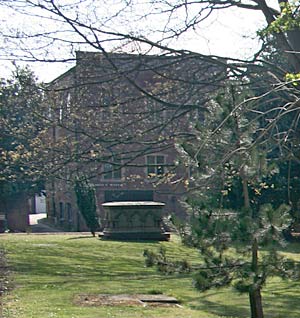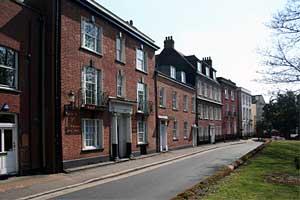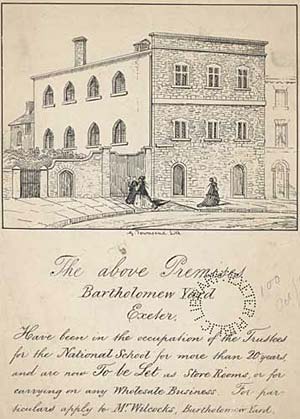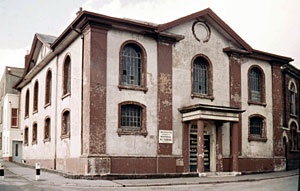
Bartholomew Street
Page Updated 2nd July 2012
 This street is named
after Bartholomew's Yard, opened on St
Bartholomew's Day 24th August 1636, by Bishop Hall.
Samuel Izacke wrote almost a hundred years late, in 1731 of the event
thus:
This street is named
after Bartholomew's Yard, opened on St
Bartholomew's Day 24th August 1636, by Bishop Hall.
Samuel Izacke wrote almost a hundred years late, in 1731 of the event
thus:
'A new Church-yard, 24 August, Saint Bartholomew's Day, was here solemnly consecrated by Bifhop Hall, a piece of Ground formerly called Friern-hay, lying within the Walls of the said City, and in the West quarter thereof,' which said Ground was given by the City, and levelled and inclosed by the concurrent Charge of both Church and City, by the Care and Vigilance of the Mayor.'
The old cemetery at Cathedral
Yard was a health
hazard due to overcrowding, thus requiring a new burial yard in the
city. The City Chamber
agreed to forgo £13 a year rent for its rack-fields at Friernhay.
The Cathedral authorities provided £150 towards establishing
the burial yard, which originally stretched down to the Snail
Tower, and the city wall overlooking Exe Island.
The land of Bartholomew's Yard was originally given to the monks of
St
Nicholas Priory by William I and named Fryers-hays. A Franciscan
Friary was established there in the 13th-century, which was moved to
land outside the Southgate in the early 14th century and which was
also, confusingly, known as Friernhay.
As already mentioned, the area was previously used for rack-fields to dry the serge from the fulling mills below, on the leats. Prior to that, up to Saxon times, the whole area was called Little Britayne and was probably a camp, with a lookout, at the point where the Snail Tower was built in the 13th-century. The new cemetery was renamed Allhallows-on-the-Wall and the street running past, became Bartholomew Street. A church was built in the nineteenth century at the southern end of the burial yard, named All Hallows on the Wall. It became a corset factory and then a parachute factory in the Second War, before it was demolished in 1951.
The last burials in the Allhallows -on-the-Wall Cemetery were conducted with much secrecy, at mid-night, during the cholera epidemic of 1832. Between July and October, six people from Bartholomew Street died of the disease.
A modern visitor to Bartholomew Yard will find a pleasant green park, with an occasional gravestone embedded flat in the grass to allow mowing. In one corner there is still a large raised Victorian tombstone of the Gidleigh family, which escaped removal when the City Council decided to make a northern inner bypass along Bartholomew Street. It was a legal requirement that they could only use land in the burial yard if all living relatives of the deceased gave permission. Living relatives of the Gidleigh's were found in America, who objected to the tomb being disturbed. Thus the residents of Bartholomew Street heaved a sigh of relief as the bypass had to be shelved.
Elsewhere in Bartholomew Street
At the Northgate end of Bartholomew Street between the City Gate Hotel and Gino's is a strip of grass - here, built on the city wall could be found a terrace of 12 almhouses, known as Lant's Almshouses, dating from 1765. They were demolished in 1959 for road widening. Mr John Gil, the eighty two year old the city cryer, resided in Lant's Almshouses in 1879. He requested from the Council a small pension, having carried the cryer's bell for 48 years. The Council already paid him £5 per year as keeper of Bartholomew's Yard. It was recommended he be granted an additonal £5 per year.
Part of the site of the building at the corner of North Street and Bartholomew Street belonging to the Church Charity Trustees was purchased to improve access into Bartholomew Street in 1874; the site is now part of a multi-storey car park. Another scheme, in 1880, to build a footbridge over the upper leat, linking Bartholomew Street with Tudor Street was not approved.
An ale house on the present site of the Hub, on the corner of Mary Arches Street, was first recorded as the London Ale House in 1816. It was demolished for road widening, and rebuilt and has been known as the Mitre, The Exhange and Three Fat Fish before it became the Hub in 2006. In 1958, the landlord, Reg Bowden, was relocated to the Spirit Vaults in South Street while the London Ale House was demolished for road widening. Reg Bowden returned to the rebuilt pub, now named the Mitre when it was complete.
Schools, and more schools
The School Board opened the Paradise Place Boys School in April 1872 in the former Devon and Exeter Infants School. The building was inadequate as more children attended, and in 1896 the foundation stone for Paradise Place School was laid on the site of the old school, and the school opened the next year. Situated below Bartholomew Terrace, it was on a steep slope, that would not allow expansion in the future. In 1918, the school was closed and the building became the Junior Technical School. The building was demolished in the 1980s to be replaced with housing and a car park.
Where Mint Lane emerges into Bartholomew Street, on the southern corner (see illustration right), is a large, rather austere building, now number 27. In 1821, in answer to a question from the Bishop, the Rector of St Olave's stated that the building was used for the Lancastrian or Dissenters School, which probably opened in 1811 or 1812. In 1835, the National School occupied the premises, remaining there until 1868. Alfred Edward Windser was a dyer, in the premises (as his works) in 1897, with a shop at 16 The Arcade, High Street. In 1930, the building was the Exeter Boy's Brigade HQ. Later in the 20th-Century, Walton's from the High Street used it as a furniture warehouse which the sign over the door in the photo states.
A pub by many names
The site of the town house to the right of the warehouse was, according to Coldridge's 1818 map, the Woolpack Inn. The 1856 will of John Bussell, solicitor, who owned Honeylands, states that the Wool Pack was previously known as “Champion Arms” and “Globe Inn”. The Flying Post reported that the Champions Arms was to be the venue for a meeting in 1829. Its only listing was in the 1830 Pigots, when Abraham Cann, the famous Devon wrestler was the proprietor, and who renamed it the Champion's Arms. Robson's Directory of Devon, 1839, lists Philip Roberts as the landlord of the Globe. It was also listed in 1844 Pigotts.
At the turn of the 20th century, St Olave's Rescue Home for Girls and St Wilfred's Home for Aged Women could be found five doors apart facing the burial yard. The handsome buildings are still there, converted into apartments and flats.
On the corner, close to the West Wall can be found the Bartholomew's Street Baptist Church, which is still serving as a place of Christian worship. The foundation stone was laid on 30 September 1817 "by a minister of Jesus Christ." The building next to the church is now used by Stage Studios for training young people in stagecraft and dance.
Close to the modern Picture House, Bart's Tavern was the Exeter Arms from at least 1816, and near the pig market. It went through the usual changes in the latter years of the last century from Barts' Tavern to the Merry Monk and back again before finally closing.
World War War Dead - Bartholomew Street
BALSON, Ordinary Seaman,
Aaron James, H.M.S. "Invincible.", Royal Navy. 31 May 1916. Age 18.
Hertford Place, Bartholomew St
COLLACOTT, Private, Albert,
Devonshire Regiment. 4 September 1916. Age 19. Bartholomew Place
COOMBES,
Private, Fred, Devonshire Regiment. 9 May 1917. Age 39. Clarendon
Place, Bartholomew St.
EDWARDS, Private, Thomas Augustus, Devonshire
Regiment. 5 July 1915. Age 19. Hick's Place, Bartholomew St. East
KNOWLES,
Private, Arthur William, Australian Infantry, 25 April 1915. Age 33.
Bartholomew St West (enlisted as Clerk)
LUCRAFT, Private, Leonard,
Hampshire Regiment. Labour Corps 6 December 1918. Age 29. Bartholomew
St East
MITCHELL, Private, Harry, Devonshire Regiment. 4 September
1917. Age 39. Bond's Terrace, Bartholomew St
PASSMORE, Sapper,
Albert Nicholas, Royal Engineers. 7 September 1917. Age 22. Ash Grove,
Bartholomew St
PENHALE, Private, Dennis Walter, Royal Berkshire
Regiment. 20 September 1918. Age 19. Bartholomew St West
Source: Izacke's Antiquities of the City of Exeter, Kelly's Directories, Flying Post, Two Thousand Years of Exeter by W G Hoskins, and Exeter 1540-1540 by MacCaffrey.
 The grave that saved
Bartholomew Street from being turned into a bypass.
The grave that saved
Bartholomew Street from being turned into a bypass.
 These houses once contained St
Olave's Rescue Home for Girls and St
Wilfred's Home for Aged Women.
These houses once contained St
Olave's Rescue Home for Girls and St
Wilfred's Home for Aged Women.
 The National School by George Townsend in 1868 – it was for let as store rooms. It started life as the Lancastrian School in 1811. The building
to the right was the site of the Woolpack Inn. Courtesy of the Westcountyr Studies Library.
The National School by George Townsend in 1868 – it was for let as store rooms. It started life as the Lancastrian School in 1811. The building
to the right was the site of the Woolpack Inn. Courtesy of the Westcountyr Studies Library.
 The Baptist Church in the
1970's. Photo Alan H Mazonovicz
The Baptist Church in the
1970's. Photo Alan H Mazonovicz
Courts and Places off Bartholomew Street
Dix's
Place
Hertford Place
Hick's Court
Paradise Place
Pubs of
Bartholomew Street
Albion
Allhallows New Inn
Bart's Tavern
Bryghtelegh Ys Inne
Buller's Arms
Bystock Inn
Champions' Arms
Globe Tavern
Golden Eagle Tavern
Hub
New Inn
Three Horse Shoes
Woolpack Inn
Also see these memories:
Around Bartholomew Street
in
the 1890s
Rescue Work in 1930's
Bartholomew Street Bartholomew
Street in the 20s and 30s.
Bartholomew Street in the 1940s
│ Top of Page │